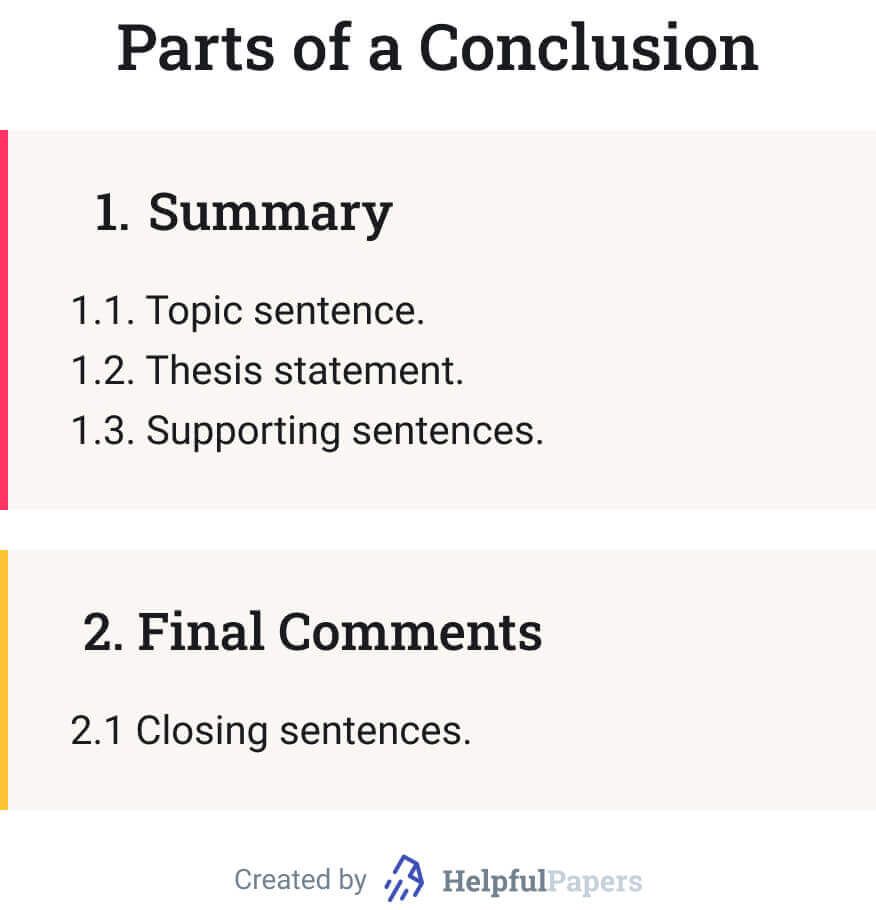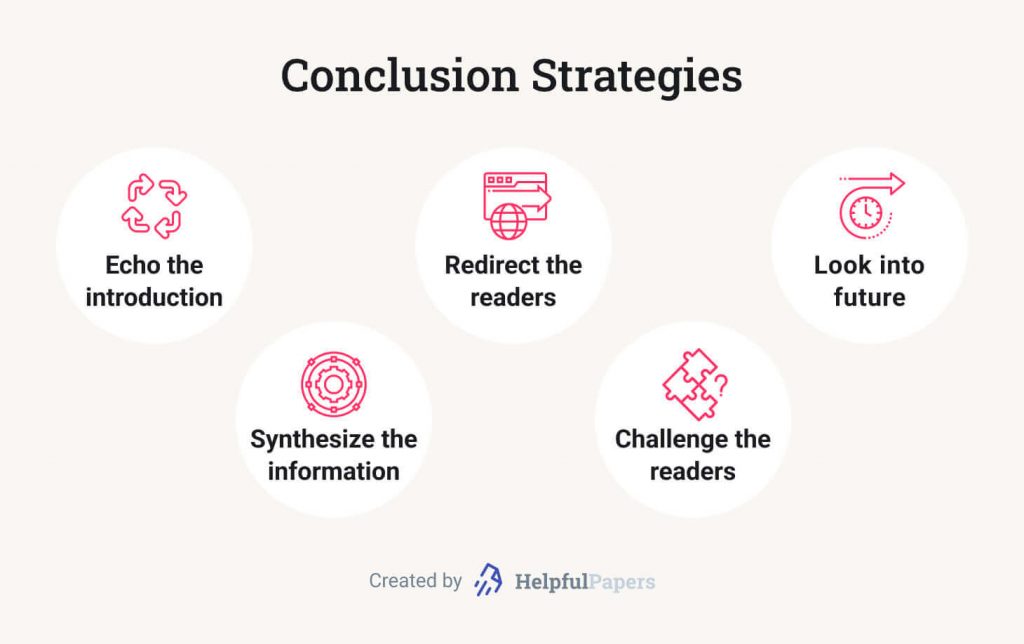🎯 What Is the Purpose of a Conclusion Paragraph?
In this list, we’ve collected the purposes of a conclusion paragraph. Here’s what you need to do:
- Summarize the information you provided earlier. It is even better if you synthesize your major points.
- Restate your main argument. Highlight the necessity of research and reinforce your strongest statements.
- Connect your research to the existing knowledge. Point out how you used and advanced past research.
- Emphasize the significance of your paper. Explain how you addressed and filled the knowledge gap you identified.
- Suggest possible directions for further research. This will show that you have a deep understanding of the problem.
- Call your audience to action. You might encourage them to do something directly or add a thought-provoking question at the end.
🧩 Parts of a Conclusion Paragraph
A college essay conclusion should include the following elements: topic sentence, restated thesis statement, supporting sentences, and closing sentences. These components should be allocated in two more extensive parts – summary and final comment.

Summary
First, begin a conclusion with a small transition and a summary of the main arguments. Then you can paraphrase your thesis and add some details to it. Remember not to add any new thoughts at this point.
Here are the parts of a summary part of a conclusion paragraph:
- Topic Sentence
Like any other opening sentence of a paragraph, a topic sentence should describe the content of your conclusion. You don’t have to make this sentence too long. Use conclusion paragraph starters from our article to make a smooth transition between the body and the conclusion. - Thesis Statement
In this part, you need to remind your readers about your thesis. Don’t simply copy it from the introduction. Choose synonyms and paraphrasing to avoid repetition. You can also use our instant paraphrase generator to simplify your work. - Supporting Sentences
It is where you synthesize your primary thoughts. Use the arguments from the paper and explain their connection. Explain the significance of your points throughout the article in your concluding paragraph. Pay attention to the choice of word – you shouldn’t repeat yourself.
Final Comments
After discussing the main points, it is time to make the final comment. Offer alternative solutions to the problem. You also might suggest further research of the issue or provide recommendations.
- Closing Sentences
In this part of your concluding paragraph, mention the point you made in the introduction. Highlight your research’s significance and achievements in filling the knowledge gap. Add some final thoughts on the subject and finish with a closing statement.
🏹 College Essay Conclusion Strategies
So, how to conclude an essay? There are different ways to do it.

Let’s take a look at some conclusion techniques you can use:
- Echo the Introduction
Reread your introduction and emphasize the thesis. Then use the “full-circle” approach. You have to connect your conclusion to the intro using the same thoughts, scenarios, or ideas. Don’t simply repeat what you’ve written. Instead, show a deeper understanding of the problems you mentioned at the beginning of your essay. - Synthesize the Information
Synthesis is not just a condensation of the significant points. Add a new meaning or perspective to the ideas you’ve provided in the body paragraphs. It doesn’t mean that you should add new information. Using your already introduced knowledge, you need to show the connections, consequences, and results. - Redirect the Readers
In this case, your goal is to bring readers back to the real world when they finish reading your article. Give your audience some food for thought. Make them think about the consequences of the issue you’ve described. Ask a difficult question, provide a reason for self-reflection, or draw a parallel with their lives. - Challenge the Readers
Give some practical solutions to the problems you’ve described. You need to convince the audience that the topic discussed in your paper relates to them. For example, they can make their lives better or save the planet if they follow your recommendations. Call them to action or explain how to use the knowledge to achieve some results. - Look into Future
Emphasize that the issue you’ve studied has more perspectives that can interest your readers. Connect your topic to broader implications. Predict how the situation might change within a certain period. Suggest ways to research the issue further.
🎬 Conclusion Paragraph Starters
If you are concerned about how to start a conclusion, this section is for you. You can use different options to avoid common phrases like “in conclusion.”
Below are the phrases that will make your transition from body to concluding paragraph smooth.
General starters for any type of essay:
1. In short…
2. To put it briefly…
3. After all…
4. In a nutshell…
5. Altogether…
6. Overall…
7. On the whole…
8. To review…
9. In summary…
10. All in all…
11. Putting it all together…
12. As a result…
13. Clearly…
14. In the end…
15. In general…
Summary starters for more advanced university research essays:
1. Upon consideration…
2. Without further ado…
3. Upon further analysis…
4. All things considered…
5. Upon reflection…
6. While further study is warranted…
7. Based on the evidence presented…
8. Upon further review…
9. To bring facts to a close…
10. Subsequently…
11. As indicated by the data…
12. Taking all of the aforementioned into account…
13. In light of this information…
14. Upon investigation…
15. In the final analysis…
✍️ College Essay Conclusion – 5 Examples
And now it’s time to look at conclusion samples for different papers. Use these examples as a reference when you start working on your essay.
Compare and Contrast Essay Conclusion | Gun Control Essay Conclusion
Compare and contrast essay aims to provide differences and similarities between two or more concepts. Let’s discuss what you should include in your compare and contrast essay conclusion:
- In this type of essay, restate the thesis and summarize the comparison provided in the body paragraphs.
- Briefly explain the connection between the subjects you studied.
- Define how you proved your thesis.
- Describe your academic impact on the area of studies if necessary.
The concluding paragraph can also indicate your opinion on the matter. If you have any final insights based on the provided information, share them. Remember that you need to stay objective and not include any new data at this stage.
Here is an example:
Argumentative Essay Conclusion | Climate Change Essay Conclusion
In an argumentative essay, your purpose is to prove that your point is valid. That is why your conclusion should be convincing and compelling.
- Remind your readers why your topic is essential.
- Move from the general information you presented to the specific details.
- Restate all of the main points described in the introduction and show how they prove your argument.
- Describe the opposing points.
- Call to action or suggest different ways of research if necessary.
It is better to mention the arguments and the counterarguments in the same order they appear in the essay.
You can use this example as a reference:
Conclusion of a Persuasive Essay | Abortion Essay Conclusion
A persuasive essay is used to convince your readers that your perspective is the only suitable option. In some cases, your goal might be to motivate your audience to act in a certain way.
- Reword the thesis statement to mention all the main points stated in the introduction.
- Connect your points with possible consequences of ignoring your message.
- Describe how the situation or the lives of the readers might change.
It is better to use visual language to picture the potential results. You can add your predictions, recommendations, or warnings. Try to finish your paper with a call to action or a memorable quote to leave the last impression.
Take a look at the example below:
Conclusion of a Descriptive Essay | Racism Essay Conclusion
A descriptive essay is one of the most creative academic paper types. Your writing goal is to help the readers visualize an object, person, situation, process, or place.
- In the concluding paragraph, summarize the key features presented in the body.
- Restate the thesis or the main thoughts of the paper.
- Make sure you don’t include any new details in conclusion. Also, don’t repeat yourself or add unnecessary information.
- Provide your perception and reflect on the subject. Explain why you have chosen this topic and what it means to you.
Consider the impression your audience will have after reading. Use words of senses and colorful phrases to create an image and enhance readers’ feelings.
Here is a descriptive essay conclusion sample:
Now you are ready to nail your papers, knowing everything about conclusions and conclusion strategies. We hope that our advice will help you reach your writing goals. To work more effectively, take notes on the most crucial information from this article.
Good luck with your essay!